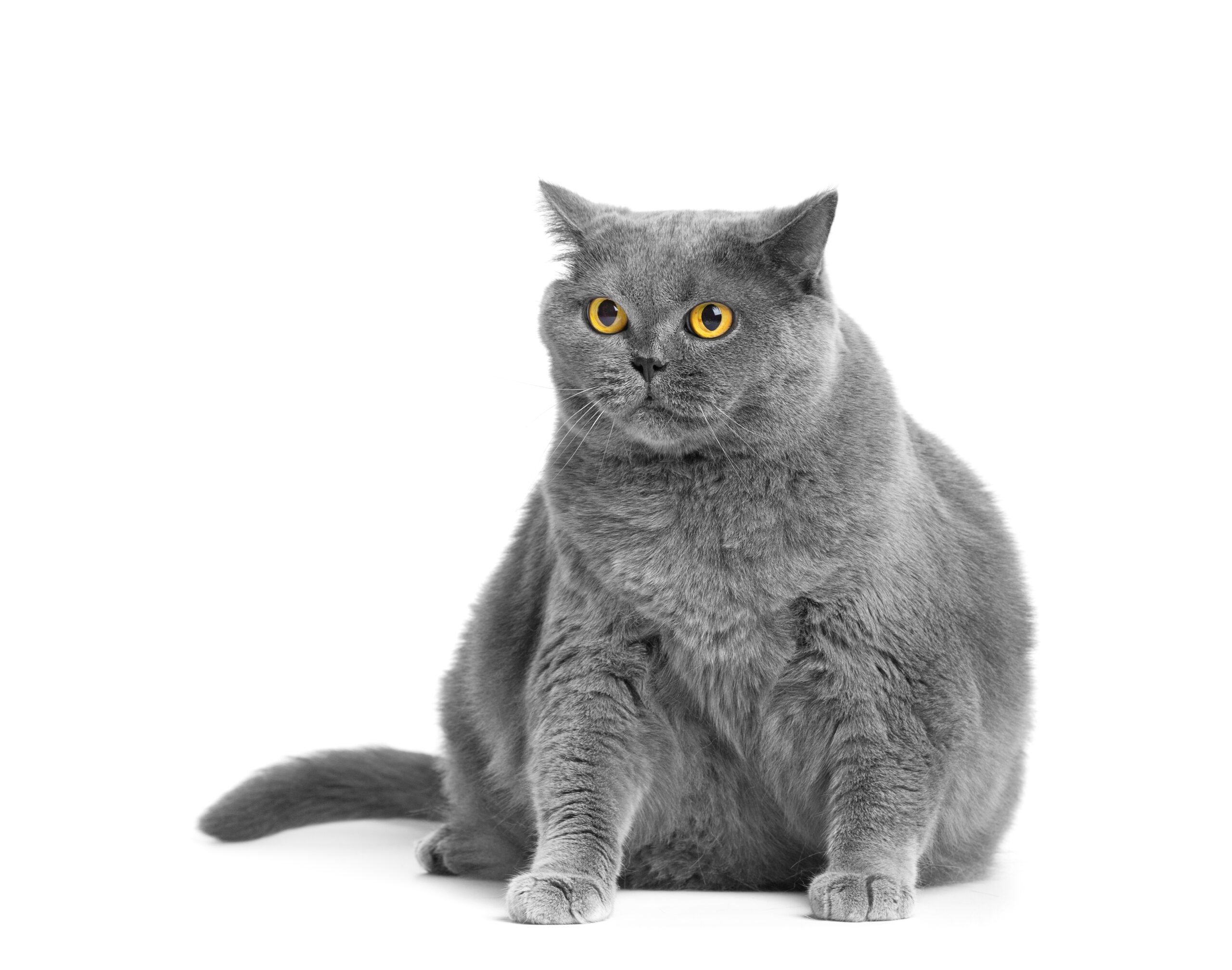Help Your Overweight Cat Lose Extra Pounds
Published on February 23, 2016

Our cats are getting fatter. As painful as it sounds, it’s painfully true. In a study conducted last year by the Association for Pet Obesity Prevention, 58 percent of cats were classified as overweight or obese by their veterinarians. That means more than 55 million cats are at increased risk for type 2 diabetes, high blood pressure, arthritis, and many forms of cancer. Excess weight is also costing cat owners untold millions in medical costs. You care about your cat; that’s why you should care about your cat’s weight.
How can I tell if my cat is overweight?
The first step in determining whether your cat is overweight is to have her evaluated by your veterinarian. Your vet will use a body condition score (BCS) combined with a weight measurement to accurately assess if your feline is too flabby. There are some easy ways for you to check your cat’s overall body condition and monitor her progress toward her body weight goals. Some simple home tests you can perform include:
- Rib check. You should be able to easily feel your pet’s ribs under a thin layer of skin. If you’re pushing through a pad of plump, your pet may be too heavy.
- Tummy test. Does your cat’s belly sag and dip toward the floor? Cats at a healthy weight will actually have a tummy that is taut, tight, and tucked upward instead of dragging down.
- Waist watch. When you look down at your pet from above, you should see a subtle hourglass silhouette and an obvious waistline.
If you think your cat is carrying a few extra pounds, she probably is.
What does obesity do to my cat?
Obesity is the No. 1 feline health threat. Heavier cats are prone to a number of weight-related disorders. If you need some motivation to help your cat slim down, consider obesity’s consequences:
Decreased life expectancy. Less is more when it comes to feeding your cat. Eating less has been proven to extend life expectancy and reduce the risk of certain diseases in species as diverse as worms, spiders, fish, hamsters, mice, dogs, and monkeys. (Studies in cats are lacking.) If you’re looking for your cat’s fountain of youth, it’s right there in the food bowl.
Diabetes. Increasingly, vets are diagnosing overweight cats with type 2 diabetes. Similar to humans, chubby cats are at tremendous risk for developing diabetes, requiring daily insulin injections. And diabetes has been shown to reduce a pet’s life expectancy. For many cats, type 2 diabetes is largely preventable by simply feeding the correct amount of food. What could be easier?
High blood pressure. Hypertension is a commonly overlooked disorder in cats and is known as the “silent killer” because you can’t see the damage it’s causing until it’s too late. If your cat has packed on extra pounds, your veterinarian may want to measure her blood pressure. This simple test can help detect a disease that causes sudden blindness, heart problems, and kidney failure.
Arthritis. A 2011 study by researchers in the Netherlands examined cats (more than 6 years of age) for signs of arthritis. The study concluded that while 61 percent of tested cats had radiographic (x-ray) evidence of arthritis, few pet owners recognized the signs of this degenerative disease in their cats. As a result, the study authors strongly recommend that x-rays be evaluated in older cats. Even if your cat is carrying as little as one or two extra pounds, those pounds are stressing tiny joints not designed to carry excess weight. Making matters worse, fat cells produce harmful chemicals known as adipocytokines that can damage even non-weight-bearing joints. There is no cure for feline arthritis; we can only minimize the pain.
Cancer. Excess fat has been implicated in the formation of many cancers in animals. The National Cancer Institute estimates that obesity and physical inactivity may account for 25 percent to 30 percent of the major cancers in humans, including colon cancer, breast cancer in postmenopausal women, and kidney cancer. If we use these studies as a benchmark, it’s possible that weight loss may reduce the cancer risk in pets too.
How can I help my cat lose weight?
Your first step is to discuss your cat’s weight with your veterinarian and come up with a reasonable weight loss goal. Your veterinarian will then work with you to initiate a weight loss plan for you to follow. Here are some tried-and-true strategies for helping your cat drop those extra pounds:
Calculate calories. If you don’t know how many calories your cat needs each day, you don’t know how much to feed her. And don’t simply go by the feeding suggestions printed on the bag.
Instead, ask your veterinarian to calculate the proper number of calories based on your cat’s age, gender, any medical conditions, and lifestyle. Another good starting point is to use this formula: Divide your pet’s ideal weight in pounds by 2.2. Multiply this figure by 30 and add 70. This number is a general estimate of how many calories you should be feeding a typical inactive, indoor spayed or neutered cat — or dog — weighing between 6 and 60 pounds. Again, this is a general rule, and the actual calorie count should be based on your vet’s specific recommendations.
Measure meals. A pet owner’s single greatest tool in the fight against excess weight is the humble measuring cup. Too many pet owners simply fill the bowl or “guesstimate” how much they’re feeding. Even worse, some owners have a “keep the bowl full” feeding mentality, allowing their cats to enjoy an all-day buffet. The Association for Pet Obesity Prevention has determined that feeding as few as 10 extra pieces of kibble per day can add up to a pound of weight gain per year in indoor cats. After you calculate how many calories your pet needs, determine how much food you should feed at each meal — and precisely measure the amount.
Treat tactically. If you’re going to give your pets extra goodies, make ’em count. I prefer single-ingredient treats, such as salmon or tuna flakes, for my felines. And be sure to count those additional calories as part of your pet’s total daily allotment. As few as 30 extra calories per day can become three pounds of weight gain over a year. Focus on praise, petting, and playing instead of treats.
Hustle for health. When it comes to living a longer, healthier life, research proves our most powerful partner is daily exercise. Try entertaining your cat with a laser pointer, remote-controlled toy, or even a ball of paper for five to 15 minutes each day. Feeding one meal on a raised surface and the next on the floor can also encourage active, mobile pets to get some extra movement.
Cut down the carbs. Most of the cats I treat don’t need a high-carbohydrate diet. Yet that’s exactly what most of us feed our felines. As a general rule, I recommend trying a higher-protein diet first for weight loss. Opinions on dietary strategies vary, so be sure to consult with your veterinarian before changing your cat’s diet. If one particular formulation doesn’t work, change tactics within three months.
Weigh in regularly. During weight loss, weigh your cat every one to three months at the veterinary clinic. I recommend a weight loss goal of one percent to two percent of body weight per week. Once your cat reaches her goal weight, weigh in every three to six months to help ensure that extra pounds aren’t sneaking back on.
What if my cat begins begging for food in the middle of the night?
I’ve seen too many cat diets derailed by begging and pestering. Some tips to avoid a 2 a.m. wake-up call include:
- Feed a high-protein diet. These tend to provide longer periods of satiety than high-carbohydrate foods.
- Offer bedtime snacks. Offer a high-protein meal or morsel of meat or fish just before you go to bed. This could be the difference between your cat waking you at 6 a.m. instead of 3 a.m.
- Use automated feeders. Try a feeder that can dispense a measured meal four to six times a day, and nourish your feline’s 4 a.m. hunger pangs.
Our goal as loving and responsible pet owners is to help our pets enjoy long and happy lives. Helping our cats maintain lean, fit bodies will go a long way toward keeping them healthy and active for years to come.
This article originally appeared in the Summer 2015 issue of HealthyPet magazine.



